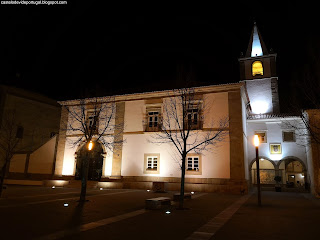- - - - - - - - - - - - - - - - - - - - - - - - - - - - - - - - - - - - - - - - - - - - - - -
GOOGLE MAPS: OPEN MAP
OFFICIAL WEBSITE: WEBSITE
Century building XVII. His works began in 1569 and were completed in 1692. The clock tower was built a little later, in 1721.In a similar style to the solar minhoto, this building has two staircases and balcony windows on the upper floor. The access to its interior is made sideways by two cradle arches, the doors being wrought iron.Already in the lobby at the lintel of the entrance door we find the arms of Portugal.The Noble Hall was restored by Master Ventura Porfírio. It has two mural paintings: one represents a bucolic landscape of the village, the other is representative of World War II where the painting "O Grito" by Münch is depicted. In the ceiling we find the representation of the four parishes of Castelo.In the Noble Hall are also exposed the "sticks of command" used by the old councilmen.City Hall:The Hall of the Town Hall of Castelo de Vide is a privileged place to welcome artistic exhibitions, both for its centrality and for its symbolism.
Edifício do séc. XVII. As suas obras iniciaram-se em
1569 e concluíram-se em 1692. A torre do relógio foi construída um pouco mais
tarde, em 1721.
Num estilo similar ao do solar minhoto, este edifício tem duas escadarias e janelas de sacada no andar superior. O acesso ao seu interior é feito lateralmente por dois arcos de berço, sendo as portas em ferro forjado.
Já no átrio no lintel da porta de entrada encontramos as armas de Portugal.
O Salão Nobre foi restaurado pelo Mestre Ventura Porfírio. Tem duas pinturas murais: uma representa uma paisagem bucólica da vila, a outra é representativa da II Guerra Mundial onde figura a pintura "O Grito" de Münch. No tecto encontramos a representação das quatro freguesias castelovidenses.
No Salão Nobre também se encontram expostas as "varas de mando" utilizadas pelos antigos vereadores.
Paços do Concelho
O Átrio dos Paços do Concelho de Castelo de
Vide é um local privilegiado para acolher mostras artísticas, quer pela sua
centralidade, quer pelo seu simbolismo.






